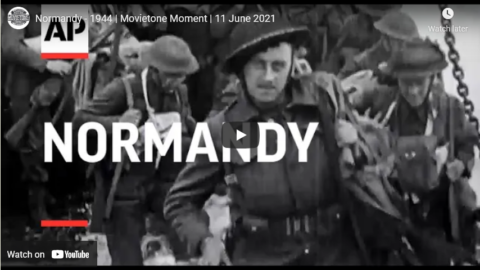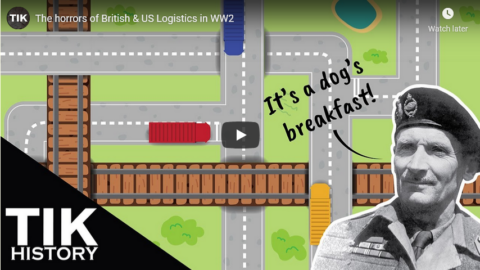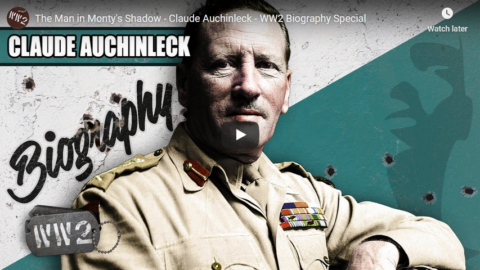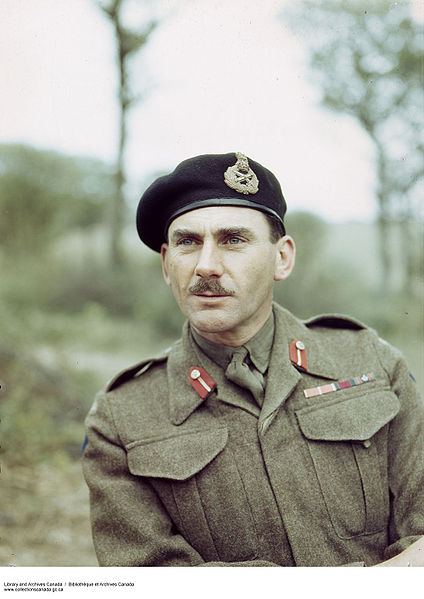World War Two
Published 4 Sep 2021As the war turns three there is is no slacking in the fighting. Erwin Rommel launches another Axis attack in North Africa, but it is foiled in only days, though the Axis are advancing in the Caucasus as well as on Stalingrad, where the fight for the suburbs is now beginning. They’re also advancing in the South Pacific, as the Japanese fight their way along the Kokoda Trail.
(more…)
September 5, 2021
This War is Three Years Old – WW2 – 158 – September 4, 1942
August 29, 2021
Yamamoto: Midway Round Two? – World War Two – 157 – August 28, 1942
World War Two
Published 28 Aug 2021The Battle of the Eastern Solomons takes place this week — another carrier battle. As for the Germans, they’re advancing on Stalingrad, slowing down in the Caucasus, and Erwin Rommel is preparing to launch another assault in North Africa.
(more…)
June 12, 2021
Normandy – 1944 | Movietone Moment | 11 June 2021
British Movietone
Published 11 Jun 2021On this day in 1944, five days after the D-Day landing, the allied forces converged in Normandy. Here is a British Movietone report covering the event.
More and more reinforcements and supplies arrive in Normandy each day. In the skies Allied air power continues to bomb and strafe the enemy. Captured German film shows Rommel and von Rundstedt visiting the vast concrete fortifications on the coast which were thought to be impassable. Mr Churchill arrived onboard HMS Kelvin and was greeted by General Montgomery as he came ashore.
Cut story – Dusk or dawn shot of destroyer with sun rising or sinking in background. Sunrise with armada in fore. Yanks board LCIs. Shots of LCTs. Beached equipment unloaded. GV of activity on beach. British troops of LTC. CU Tedder on bridge of ship. GS of Ramsay & Vian. Tedder, Ramsay & Vian walk along raft into camera. Elevated shot of activity on beach, very good. Troops build airstrip, bulldozers etc. at work. Plane takes off. Camera gun – shooting up trains, transport, & other targets, several large explosions. British pass through street, Frenchmen look on. AFU – British soldiers at look-out with field glasses. Troops (Canadian or British) run through fields & wooded country. Troops through street, French clap. Army transport passes through street, directed by soldier. Yanks march through streets. POW along roads, & over beach, wade out to LCT, one attempts to pull up sock while walking. Captured German reel GS of Rommel & Rundstedt. CU Rommel. SCU of coastal guns, & various shots of fortifications, pillboxes etc. Rommel & Rundstedt walk round inspecting same, look at double barrel coastal gun. SCU of barrel of guns, & various shots of Atlantic Wall (AFU British troops knock part of “Wall” down which they have captured). Eisenhower, Marshall & Arnold on bridge of ship. GV of destroyer Kelvin at sea – very good. CU Churchill in Trinity House uniform, wearing glasses. Churchill assists Brooke with “Mae West” life jackets. Both seated on deck Kelvin at sea. CU Churchill. Kelvin passes Nelson, Ramillies & other warships also large part of armada. Churchill transfers … ships, sailors cheer as he leaves. CU Churchill. CU Smuts both very good. Churchill, Smuts & Brooke in “Duck” [DUKW]. Churchill leans over side talks to Montgomery, Churchill alights from “Duck”. Shakes hands with Monty. The above four in group on beach, walk through crowds of soldiers. AFU – Monty stands on raised platform addresses troops (silent) Monty & Churchill through crowds. Churchill with Monty & climbs into Jeep. SEE STORY NUMBER 44914/2 & 44914/3 FOR CUTS
AP Has HD copy – HD ProRes 422 4:3 – 24fpsDisclaimer: British Movietone is an historical collection. Any views and expressions within either the video or metadata of the collection are reproduced for historical accuracy and do not represent the opinions or editorial policies of the Associated Press.
You can license this footage for commercial use through AP Archive – the story number bm44914
#Normandy #WWII #DDay
Find out more about AP Archive: http://www.aparchive.com/HowWeWork
Twitter: https://twitter.com/AP_Archive
Tumblr: https://aparchives.tumblr.com/
Instagram: https://www.instagram.com/APNews/
March 16, 2021
The horrors of British & US Logistics in WW2
TIK
Published 15 Mar 2021The Allies may have had a lot of resources, manpower and industry, but that didn’t mean that their logistics weren’t inefficient or a disorganized mess. Today, we’re going to look at how the British railways were disaster during WW2, how the Americans ran out of fuel on the way to Germany, and why Montgomery called the planning for the invasion of Sicily a “dog’s breakfast”.
⏲️ Videos EVERY Monday at 5pm GMT (depending on season, check for British Summer Time).
The thumbnail for this video was created by Terri Young. Need graphics? Check out her website here https://www.terriyoungdesigns.co.uk/
– – – – –
📚 BIBLIOGRAPHY / SOURCES 📚
Dunn, W. The Soviet Economy and the Red Army, 1930-1945. Praeger Publishers, 1995.
Garvey, J. Operation Husky: The Untold Story of the logistics of the Sicily Invasion. Farm Publications, Kindle 2019.
Hazlitt, H. Economics in One Lesson: The Shortest & Surest Way to Understand Basic Economics. Three Rivers Press, 1979.
MacDonald, J. Supplying the British Army in the Second World War. Pen & Sword Military, Kindle 2020.
Molony, C. The Mediterranean and Middle East, Volume V, The Campaign in Sicily 1943 and The Campaign in Italy 3rd September 1943 to 31st March 1944. The Naval & Military Press LTD 2004, first published in 1973.
Wolmar, C. Fire & Steam: How the Railways Transformed Britain. Atlantic Books, Kindle 2007.British Government, Railways Act 1921, https://www.legislation.gov.uk/ukpga/…
Full list of all my sources https://docs.google.com/spreadsheets/…
– – – – –
⭐ SUPPORT TIK ⭐
This video isn’t sponsored. My income comes purely from my Patreons and SubscribeStars, and from YouTube ad revenue. So, if you’d like to support this channel and make these videos possible, please consider becoming a Patreon or SubscribeStar. All supporters who pledge $1 or more will have their names listed in the videos. For $5 or more you can ask questions which I will answer in future Q&A videos (note: I’m behind with the Q&A’s right now, and have a lot of research to do to catch up, so there will be a delay in answering questions). There are higher tiers too with additional perks, so check out the links below for more details.
https://www.patreon.com/TIKhistory
https://www.subscribestar.com/tikhistoryThank you to my current supporters! You’re AWESOME!
– – – – –
ABOUT TIK 📝
History isn’t as boring as some people think, and my goal is to get people talking about it. I also want to dispel the myths and distortions that ruin our perception of the past by asking a simple question – “But is this really the case?”. I have a 2:1 Degree in History and a passion for early 20th Century conflicts (mainly WW2). I’m therefore approaching this like I would an academic essay. Lots of sources, quotes, references and so on. Only the truth will do.
This video is discussing events or concepts that are academic, educational and historical in nature. This video is for informational purposes and was created so we may better understand the past and learn from the mistakes others have made.
September 23, 2020
The Man in Monty’s Shadow – Claude Auchinleck – WW2 Biography Special
World War Two
Published 22 Sep 2020Claude Auchinleck put military matters over that of politics. Although this angered some, mainly Churchill, Auchinleck still found himself in India, and later facing down Rommel in North Africa.
Join us on Patreon: https://www.patreon.com/TimeGhostHistory
Or join The TimeGhost Army directly at: https://timeghost.tvCheck out our TimeGhost History YouTube Channel: https://www.youtube.com/c/timeghost?s…
Follow WW2 day by day on Instagram @ww2_day_by_day – https://www.instagram.com/ww2_day_by_day
Between 2 Wars: https://www.youtube.com/playlist?list…
Source list: http://bit.ly/WW2sourcesHosted by: Indy Neidell
Written by: Francis van Berkel
Director: Astrid Deinhard
Producers: Astrid Deinhard and Spartacus Olsson
Executive Producers: Astrid Deinhard, Indy Neidell, Spartacus Olsson, Bodo Rittenauer
Creative Producer: Maria Kyle
Post-Production Director: Wieke Kapteijns
Research by: Lennart Visser
Edited by: Monika Worona
Sound design: Marek KamińskiColorizations by:
Norman StewartSources:
National Portrait Gallery
USHMMArchive by Screenocean/Reuters https://www.screenocean.com.
A TimeGhost chronological documentary produced by OnLion Entertainment GmbH.
June 15, 2018
QotD: Churchill on Montgomery
There was a brief firestorm in Britain when a photograph appeared in the press of Montgomery and Gen. Wilhelm Ritter von Thoma, the commander of the Afrika Korps and the highest-ranking German captured at Alamein. After his capture Thoma was brought to the Eighth Army command post, where Montgomery accorded him the respect of one honorable professional soldier to another. The two dined that night, and the photograph of the two generals led Brendan Bracken to send Churchill a memo criticizing Montgomery’s naïveté and noting that it created a bad impression with the public. Churchill merely commented: “I sympathize with Gen. von Thoma. Defeated, humiliated, in captivity, and,” after pausing for effect, “dinner with General Montgomery.”
Carlo d’Este, Warlord: A life of Winston Churchill at war, 1874-1945, 2008.
December 27, 2014
Who should have been the allied commanders on D-Day?
Nigel Davies ventures into alternatives again, this time looking at who were the best allied generals for the D-Day invasion (for the record, he’s quite right about the best Canadian corps commander):
The truth is that any successful high command should maximise the chances of success of any campaign by choosing the ‘best fit’ for the job.
But that is not how generals were chosen for D Day.
(I would love to start with divisional commanders, but there are way too many, so for space I will start with Corps and Army commanders, and work up to the top).
The outstanding Canadian of the campaign for instance was Guy Simonds. Described by many as the best Allied Corps commander in France, and credited with re-invigorating the Canadian Army HQ when he filled in while his less successful superior Harry Crerar was sick, Simonds was undoubtedly the standout Canadian officer in both Italy and France.Lieutenant General Guy Simonds, commander of the 2nd Canadian Corps.
He was however, the youngest Canadian division, corps or army commander, and the speed of his promotions pushed him past many superiors. He was also described as ‘cold and uninspiring’ even by those who called him ‘innovative and hard driving’. It can be taken as a two edged sword that Montgomery thought he was excellent (presumably implying Montgomery like qualities?) But his promotions seemed more related to ability than cronyism, and his achievements were undoubted.
Should he have been the Canadian Army commander instead of Crerar? Yes. Arguments against were mainly his lack of seniority, and lack of experience. but no Canadian had more experience, and lack of seniority was no bar in most of the other Allied armies.
It comes down to the simple fact that the Allied cause would have been better served by having Simonds in charge of Canadian forces than Crerar.
Simonds was a brilliant corps commander and (at least) a very good army commander, but he had one fatal flaw: he was no politician. Harry Crerar was a very “political” general, and played the political game with far greater talent than any other Canadian general. That got him into his role as army commander and his political skills kept him there despite the better “military” options available.
February 4, 2014
“Chateau” generals
Nigel Davies has written a long post about the British and American standard of generalship in the two world wars, which won’t win him very many American (or Canadian) fans. That being said, he’s certainly right about the Canadian generals of WW2:
Contention: American senior generals in World War II were as bad, and for the same reason, as British senior generals in World War I.
[…] the politicians (and I will include Kitchener here, as he was by this time a politician with a military background rather than a real general), had based their recruiting campaign on a trendy ‘new model’ citizens army, rather than use the well developed existing territorial reserve system that would have done a far better job. They new enthusiastic troops were considered incapable of the traditional fire and movement approach of professional troops (the type that the Germans reintroduced in 1918 with their ‘commando units’, and the British army was able to copy soon after with properly trained and combat experienced personnel). Instead the enthusiastic amateurs were considered too badly trained to do more than advance in long straight lines… straight into the meat grinder.
Having said that the generals blame for the results should be at the very least shared with their political masters, I am still willing to express dissatisfaction with the approach of Haig and many of his senior commanders. They were Chateau Generals in approach and in attitude. They drew lines on maps without adequately considering the terrain, issued impossible instructions without looking at the state of the ground, and ran completely inadequate communications that were far from capable of keeping track of, or controlling, a modern battlefield.
[…]
It was noticeable later in the war that the more successful armies were commanded by competent and imaginative officers who insisted on detailed planning; intensive and specific tactical planning and operational training (down to practicing assaults on purpose built life size models); and very close control of operations to ensure success. They had usually learned the hard way, and had matured as experienced and pro-active leaders.
Of course some of this improvement was simply advances in technology. Tanks to breakthrough; better artillery fire plans to support and reduce casualties; air observation to enhance control and assess responses; better communications (including radio’s) to facilitate flexibility on the ground; and a generally better trained and more experienced soldier; with much more skilled officers. It all helped. But a lot came down to the attitude of the generals who believed that you got up front, found out the truth, stayed in close contact, and reacted to changed circumstances as immediately as possible.
However, as the American army was late to the battlefront, Davies contends that the leaders merely recapitulated the first stages of the bloody learning experience as their British counterparts, but didn’t produce the innovative leadership to match the Germans:
The Americans arrived on the Western Front when the war was already won. Only a few thousand were there for the last big German push, and by the time the Allies were moving to their final offensives with real American numbers involved, the German army was a broken reed. Which means that most American officers had only a few weeks of combat experience, and almost all of it against a failing army which had little resilience left to offer the type of resistance that might have caused the inexperienced American officers to have to reconsider their theories from their quicky officer training courses. Even the professional military officers received, at best, only a couple of hints that their ideas might not be inevitably effective against a stronger opponent. Certainly not enough time to learn how to analyse and adapt to circumstances in serious combat.
Which is why the majority of highly recognised American higher commanders in World War II appear to be chateau generals.
[…]
Eisenhower’s mistakes in theatre commands in Italy and France were possibly no worse in results than Wilson’s ongoing problems with Greece (he led the ‘forlorn hopes’ of both 1941 and 1944 there), but Eisenhower failed far more spectacularly with the Italian surrender, the Broad Front strategy, and the Bulge, than Wilson ever did with far inferior resources. MacArthur’s failures are more readily compared with Percival than the successes of a man like Leese, and Nimitz is often referred to as one of the great captains of history, for defeating a navy that repeatedly sabotaged its own efforts in the Pacific theatre. (Often by people who haven’t seemed to have ever heard of Max Horton’s much harder victory against the ruthlessly efficient U-boat campaign in the Atlantic theatre).
Similarly it is fair to say that the American front line commanders most people have never heard of were hardly inferior to their famous British contemporaries. Eichelberger was as good a commander, and as good a co-operator in Allied operations, as Alexander ever was. Truscott was probably at least the equal of Montgomery, given the opportunity. (I suspect possibly even better actually, but who can say?) Simpson, in his brief few months at the front, impressed many British officers who had served for years under men as good as Slim. And Ridgway showed in his few months of active operations a level of skill and competence (not necessarily the same thing) that far more experienced men like O’Connor did not surpass.
Why do we hear about the American chateau generals in preference to their front line leaders? And why do we hear about the British front line leaders in preference to their back office superiors. I would say it is because the British had been through a learning process in WWI that the Americans had not.
And the Canadian angle? As I’ve noted before, the First Canadian Army (scroll down to the item on John A. English’s book) was not as combat-effective in WW2 as the Canadian Corps had been in the First World War. One of the most obvious failings was in the advance to Antwerp:
Note that the equivalent British debacle during that campaign was when the Canadian Army took Antwerp undamaged, but then stopped for a rest before cutting off the retreating Germans. The Germans quickly fortified the riverbanks leading to the port, keeping it out of use for months. This was a clear example of the Canadian generals inexperience, and Montgomery is at fault here for being too involved in the last attempt to break the Germans before Christmas — Market Garden — and not paying close enough attention to one of his Army commanders, who was not supervising his Corps commander, who was not chasing his divisional commander adequately. (No one is imune from such glitches in a fast moving campaign. Inexperience any where down the chain can cause big problems. But it is noticeable that Crerar’s failure did not get him the public acclaim Patton has enjoyed?) Crerar was a ‘political appointment’ by the Canadians (an ‘able administrator’, but militarily ‘mediocre’ according to most) who Montgomery considered to be as inferior in experience and attitude as many of the American ‘chateau leaders’ he would have put in the same basket. By contrast Monty was delighted when the more competent front line leaders – the Canadian Simonds and the American Simpson – were assigned to him instead. As in the cases of the Australian General Morshead or the Polish General Anders, Montgomery only cared about ability, not nationality. But as was the case with the Americans, all too many generals in most armies, including the British and German armies, lacked experience or ability.
Update, 13 February: Mark Collins linked to an earlier post that helpfully describes some of the problems with Canadian generalship in Europe:
The Canadian command style in WW II was even more stuck in the mud than the American. With a few exceptions (McNaughton, Burns, Crerar) most Canadian generals had little or no General Staff experience, and those that did were practitioners of a successful, for the earlier WW I time and place, doctrine based on set piece battles founded on the systematic and intensive use of artillery.
One virtue of the German system is that it allowed officers to make mistakes: it did not allow them to sit on their butts waiting for orders; it encouraged risk taking which often worked but sometimes ended in bloody disaster (indeed it’s amazing it didn’t in France in 1940).
Indeed comparing the Canadian Army in WWII with the German is very difficult. Both had to expand from a tiny base to their war-time peak, but the Germans began in 1933 (actually even before then); we didn’t really begin until 1940. The Germans lost the Great War and the Reichswehr gave serious thought to how to do better next time.
One thing underlying the British set piece battle approach and limited freedom for commanders – the one the Canadian Army followed – seems to have been their realization in the late 1930s that the British Army was simply not as good as its 1914 ancestor. That was partly because of the losses of promising junior officers who never made general [though that affected the Germans too], partly because of indifference to defence at the governmental level, and partly because the military lapsed all too happily back into “real soldiering” in the 20’s.







